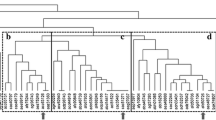Abstract
Objective
To determine whether the G–H loop of foot-and-mouth disease virus (FMDV) serotype O can function as a target structure to harbour and display serotype Asia1 antigenic epitope at the surface.
Results
Using reverse genetics, FMDV serotype O IND R2/1975 displaying a FMDV serotype Asia1 B cell epitope at the capsid surface was constructed. The epitope-inserted recombinant chimeric virus was genetically stable up to ten serial passages in cell culture and exhibited growth properties similar to the parental serotype O virus. Furthermore, the surface-displayed Asia1 epitope able to react with serotype Asia1 specific antibodies in a competitive ELISA. Importantly, the recombinant chimeric virus showed neutralizing activity to both serotype O and Asia1 polyclonal antibodies.
Conclusion
The capsid protein of FMDV serotype O can effectively display potent epitope of other serotypes, making this an attractive approach for the design of new generation bi-valent FMD vaccines.






Similar content being viewed by others
References
Acharya R, Fry E, Stuart D, Fox G, Rowlands D, Brown F (1989) The three-dimensional structure of foot-and-mouth disease virus at 2.9 Å resolution. Nature 337:709–716
Alam SM, Amin R, Rahman MZ, Hossain MA, Sultana M (2013) Antigenic heterogeneity of capsid protein VP1 in foot-and-mouth disease virus (FMDV) serotype Asia1. Adv Appl Bioinform Chem. 6:37–46
Bachrach HL, Callis JJ, Hess WR, Patty RE (1957) A plaque assay for foot-and-mouth disease virus and kinetics of virus reproduction. Virology 4:224–236
Biswal JK, Bisht P, Subramaniam S, Ranjan R, Sharma GK, Pattnaik B (2015) Engineering foot-and-mouth disease virus serotype O IND R2/1975 for one-step purification by immobilized metal affinity chromatography. Biologicals 43:390–398
Brehm KE, Kumar N, Thulke HH, Haas B (2008) High potency vaccines induce protection against heterologous challenge with foot-and-mouth disease virus. Vaccine 26:1681–1687
Casal JI, Rueda P, Hurtado A (1999) Parvovirus-like particles as vaccine vectors. Methods 19:174–186
Eckhart L, Raffelsberger W, Ferko B, Klima A, Purtscher M, Katinger H, Ruker F (1996) Immunogenic presentation of a conserved gp41 epitope of human immunodeficiency virus type 1 on recombinant surface antigen of hepatitis B virus. J Gen Virol 77:2001–2008
Fernandez-Fernandez MR, Martinez-Torrecuadrada JL, Casal JI, Garcia JA (1998) Development of an antigen presentation system based on plum pox potyvirus. FEBS Lett 427:229–235
Grubman MJ, Baxt B (2004) Foot-and-mouth disease. Clin Microbiol Rev 17:465–493
Hassani-Mehraban A, Creutzburg S, van Heereveld L, Kormelink R (2015) Feasibility of Cowpea chlorotic mottle virus-like particles as scaffold for epitope presentations. BMC Biotechnol 15:80
Jackson T et al (1997) Arginine-glycine-aspartic acid-specific binding by foot-and-mouth disease viruses to the purified integrin alpha (v) beta3 in vitro. J Virol 71:8357–8361
Logan D et al (1993) Structure of a major immunogenic site on foot-and-mouth disease virus. Nature 362:566–568
Mackay DK, Bulut AN, Rendle T, Davidson F, Ferris NP (2001) A solid-phase competition ELISA for measuring antibody to foot-and-mouth disease virus. J Virol Meth 97:33–48
Mateu MG, Camarero JA, Giralt E, Andreu D, Domingo E (1995) Direct evaluation of the immunodominance of a major antigenic site of foot-and-mouth disease virus in a natural host. Virology 206:298–306
Netter HJ, Macnaughton TB, Woo WP, Tindle R, Gowans EJ (2001) Antigenicity and immunogenicity of novel chimeric hepatitis B surface antigen particles with exposed hepatitis C virus epitopes. J Virol 75:2130–2141
Paton DJ, Sumption KJ, Charleston B (2009) Options for control of foot-and-mouth disease: knowledge, capability and policy. Philos Trans R Soc Lond Ser B 364:2657–2667
Remond M et al (2009) Infectious bursal disease subviral particles displaying the foot-and-mouth disease virus major antigenic site. Vaccine 27:93–98
Rieder E, Baxt B, Lubroth J, Mason PW (1994) Vaccines prepared from chimeras of foot-and-mouth disease virus (FMDV) induce neutralizing antibodies and protective immunity to multiple serotypes of FMDV. J Virol 68:7092–7098
Rueda P et al (1999) Engineering parvovirus-like particles for the induction of B-cell, CD4(+) and CTL responses. Vaccine 18:325–332
Sanyal A, Gurumurthy CB, Venkataramanan R, Hemadri D, Tosh C (2003) Antigenic characterization of foot-and-mouth disease virus serotype Asia1 field isolates using polyclonal and monoclonal antibodies. Vet Microbiol 93:1–11
Verdaguer N et al (1998) A similar pattern of interaction for different antibodies with a major antigenic site of foot-and-mouth disease virus: implications for intratypic antigenic variation. J Virol 72:739–748
Wang H, Zhao L, Li W, Zhou G, Yu L (2011) Identification of a conformational epitope on the VP1 G–H loop of type Asia1 foot-and-mouth disease virus defined by a protective monoclonal antibody. Vet Microbiol 148:189–199
Wang H, Xue M, Yang D, Zhou G, Wu D, Yu L (2012) Insertion of type O-conserved neutralizing epitope into the foot-and-mouth disease virus type Asia1 VP1 G–H loop: effect on viral replication and neutralization phenotype. J Gen Virol 93:1442–1448
Acknowledgments
This work was supported by Indian Council of Agricultural Research (ICAR) under the Project IXX10081.
Author information
Authors and Affiliations
Corresponding author
Ethics declarations
Conflict of interests
The authors declare that they have no conflicts of interests.
Research involved in animal participants
This study complied with international standards for animal welfare.
Rights and permissions
About this article
Cite this article
Biswal, J.K., Ranjan, R. & Pattnaik, B. Chimeric foot-and-mouth disease virus serotype O displaying a serotype Asia1 antigenic epitope at the surface. Biotechnol Lett 38, 1509–1517 (2016). https://doi.org/10.1007/s10529-016-2121-4
Received:
Accepted:
Published:
Issue Date:
DOI: https://doi.org/10.1007/s10529-016-2121-4




